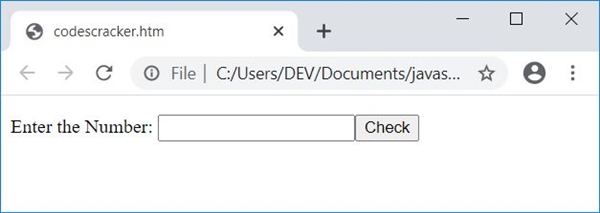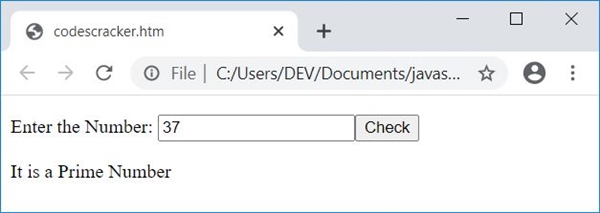- JavaScript Programs
- JavaScript Programs
- JavaScript Add Two Numbers
- JS Add Subtract Multiply Divide
- JavaScript Check Even/Odd
- JavaScript Add n Numbers
- JavaScript Add Number's Digit
- JavaScript Check Leap Year
- JavaScript Check Prime Number
- JavaScript Check Vowel or Not
- JavaScript Tutorial
- JavaScript Tutorial
- Computer Programming
- Learn Python
- Python Keywords
- Python Built-in Functions
- Python Examples
- Learn C++
- C++ Examples
- Learn C
- C Examples
- Learn Java
- Java Examples
- Learn C#
- Learn Objective-C
- Web Development
- Learn HTML
- Learn CSS
- Learn SQL
- Learn PHP
JavaScript program to check prime numbers
In this article, you will learn and get code to check whether the number entered by the user is a prime number or not in JavaScript. Here is the list of programs you will go through:
- Check Prime Number or Not. This program does not allow the user to enter the data.
- Check whether a number entered by the user is a Prime number or not. This program allows the user to enter the number
What is a prime number?
A prime number is a number that can only be divided exactly by 1 and the number itself. For example, 2, 3, 5, 7, 13, 17, etc.
As you can clearly see, the number 17 can only be divided by 1 and 17. Similarly, 13 can only be divided by 1 and 13.
Check Prime Number in JavaScript
Here is the simplest JavaScript program to check whether a number is a prime number or not. This program does not take input from the user.
<!doctype html> <html> <body> <script> var num, i, chk=0; num=19; for(i=2; i<num; i++) { if(num%2==0) { chk++; break; } } if(chk==0) document.write(num + " is a Prime Number"); else document.write(num + " is not a Prime Number"); </script> </body> </html>
Save this code in a file with .html extension. Open the file in a web browser. Here is the output produced:

Now change the value of num to 20. That is, initialize 20 to num. Save the code and open it again, or refresh the browser. Here is the output you will see:

Note: The document.write() method writes data into an HTML output.
Get Number Input from the User
Here is another program that asks the user to enter a number to check and print whether the number entered is a prime number or not.
<!doctype html> <html> <head> <script> var num, i, chk, temp; function checkPrime() { num = parseInt(document.getElementById("num").value); if(num) { chk=0; temp = document.getElementById("resPara"); temp.style.display = "block"; for(i=2; i<num; i++) { if(num%2==0) { chk++; break; } } if(chk==0) document.getElementById("res").innerHTML = "a Prime"; else document.getElementById("res").innerHTML = "not a Prime"; } } </script> </head> <body> <p>Enter the Number: <input id="num"><button onclick="checkPrime()">Check</button></p> <p id="resPara" style="display:none;">It is <span id="res"></span> Number</p> </body> </html>
Here is its sample output:

Now supply any number, say 37, and click on the "Check" button to check and print a message that tells whether it is a prime number or not, as shown in the snapshot given below:

The following code:
style="display:none;"
is a CSS code that hides an HTML element where it is present. Because it is present in a p (paragraph) tag whose id is resPara, this paragraph gets hidden initially.
When the user clicks on the button "Check," a function named checkPrime() gets called. The following JavaScript code:
num = parseInt(document.getElementById("num").value);
states that an int (integer) value of an HTML element whose id is num gets initialized to num variable. If num holds any value (instead of nothing or empty), the condition of if, num evaluates to be true, therefore program flow goes inside the loop.
The following JavaScript statement:
temp.style.display = "block";
states that an HTML element whose id is stored in the temp variable gets visible after executing this code. And the following code:
document.getElementById("res").innerHTML = "a Prime";
states that the string value a Prime gets written to an HTML element whose id is res
Live Output of the Previous Program
Here is the live output of the previous JavaScript program that asked the user to enter a number and checked whether it was a prime number or not.
Enter the Number:
« Previous Program Next Program »